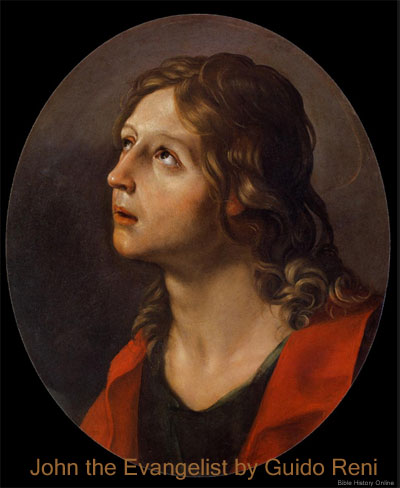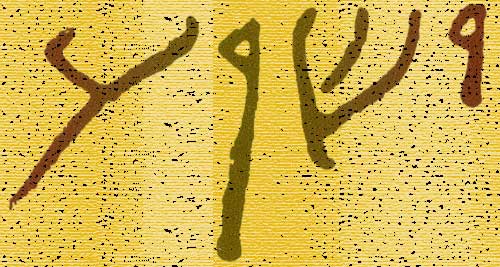2. The harmonious unity of Scripture is herein exhibited. The
Fathers compared it to a ring, an unbroken circle, returning into
itself. Between the events of Genesis and those at the close of the
Apocalypse, at least six thousand or seven thousand years intervene;
and between Moses the first writer and John the last about one thousand
five hundred years. How striking it is that, as in the beginning we
found Adam and Eve, his bride, in innocence m Paradise, then tempted by
the serpent, and driven from the tree of life, and from the pleasant
waters of Eden, yet not without a promise of a Redeemer who should
crush the serpent; so at the close, the old serpent cast out for ever
by the second Adam, the Lord from heaven, who appears with His Bride,
the Church, in a better Paradise, and amidst better waters
(Re 22:1):
the tree of life also is there with all its healing properties,
not guarded with a flaming sword, but open to all who overcome
(Re 2:7),
and there is no more curse.
street of it--that is, of the city.
on either side of the river--ALFORD
translates, "In the midst of the street of it (the city) and of the
river, on one side and on the other" (for the second Greek,
"enteuthen," A, B, and Syriac read, ekeithen: the
sense is the same; compare Greek,
Joh 19:18);
thus the trees were on each side in the middle of the space between the
street and the river. But from
Eze 47:7,
I prefer English Version. The antitype exceeds the type: in the
first Paradise was only one tree of life; now there are "very
many trees at the bank of the river, on the one side and on the
other." To make good sense, supposing there to be but one
tree, we should either, as MEDE, suppose that the
Greek for street is a plain washed on both sides
by the river (as the first Paradise was washed on one side by the
Tigris, on the other by the Euphrates), and that in the midst of the
plain, which itself is in the midst of the river's branches, stood the
tree: in which case we may translate, "In the midst of the street
(plain) itself, and of the river (having two branches flowing)
on this and on that side, was there the tree of life." Or else with
DURHAM suppose, the tree was in the midst
of the river, and extending its branches to both banks. But compare
Eze 47:12,
the millennial type of the final Paradise; which shows that there are
several trees of the one kind, all termed "the tree of life." Death
reigns now because of sin; even in the millennial earth sin, and
therefore death, though much limited, shall not altogether cease. But
in the final and heavenly city on earth, sin and death shall utterly
cease.
yielded her fruit every month--Greek, "according to each
month"; each month had its own proper fruit, just as different seasons
are now marked by their own productions; only that then, unlike now,
there shall be no season without its fruit, and there shall be
an endless variety, answering to twelve, the number symbolical
of the world-wide Church (compare Note, see on
Re 12:1;
Re 21:14).
ARCHBISHOP WHATLEY thinks
that the tree of life was among the trees of which Adam freely
ate
(Ge 2:9, 16, 17),
and that his continuance in immortality was dependent on his
continuing to eat of this tree; having forfeited it, he became
liable to death; but still the effects of having eaten of it for a time
showed themselves in the longevity of the patriarchs. God could
undoubtedly endue a tree with special medicinal powers. But
Ge 3:22
seems to imply, man had not yet taken of the tree, and that if
he had, he would have lived for ever, which in his then fallen state
would have been the greatest curse.
leaves . . . for . . . healing--
(Eze 47:9, 12).
The leaves shall be the health-giving preventive securing
the redeemed against, not healing them of, sicknesses, while "the fruit
shall be for meat." In the millennium described in
Eze 47:1-23
and Re 20:1-15,
the Church shall give the Gospel-tree to the nations outside Israel and
the Church, and so shall heal their spiritual malady; but in the
final and perfect new Jerusalem here described, the state
of all is eternally fixed, and no saving process goes on any longer
(compare
Re 22:11).
ALFORD utterly mistakes in speaking of "nations
outside," and "dwelling on the renewed earth, organized under kings,
and saved by the influences of the heavenly city" (!) Compare
Re 21:2, 10-27;
the "nations" mentioned
(Re 21:24)
are those which have long before, namely, in the millennium
(Re 11:15),
become the Lord's and His Christ's.
JFB.
The Book of Revelation
Revelation 1:9-11 - I John, who also am your brother, and companion in tribulation, and in the kingdom and patience of Jesus Christ, was in the isle that is called Patmos, for the word of God, and for the testimony of Jesus Christ. I was in the Spirit on the Lord's day, and heard behind me a great voice, as of a trumpet, Saying, I am Alpha and Omega, the first and the last: and, What thou seest, write in a book, and send [it] unto the seven churches which are in Asia; unto Ephesus, and unto Smyrna, and unto Pergamos, and unto Thyatira, and unto Sardis, and unto Philadelphia, and unto Laodicea.
Revelation 19:11-16 - And I saw heaven opened, and behold a white horse; and he that sat upon him [was] called Faithful and True, and in righteousness he doth judge and make war. His eyes [were] as a flame of fire, and on his head [were] many crowns; and he had a name written, that no man knew, but he himself. And he [was] clothed with a vesture dipped in blood: and his name is called The Word of God. And the armies [which were] in heaven followed him upon white horses, clothed in fine linen, white and clean. And out of his mouth goeth a sharp sword, that with it he should smite the nations: and he shall rule them with a rod of iron: and he treadeth the winepress of the fierceness and wrath of Almighty God. And he hath on [his] vesture and on his thigh a name written, KING OF KINGS, AND LORD OF LORDS.
Revelation 22:18-20 For I testify unto every man that heareth the words of the prophecy of this book, If any man shall add unto these things, God shall add unto him the plagues that are written in this book: And if any man shall take away from the words of the book of this prophecy, God shall take away his part out of the book of life, and out of the holy city, and [from] the things which are written in this book. He which testifieth these things saith, Surely I come quickly. Amen. Even so, come, Lord Jesus.
Revelation in The New Testament - A Brief Overview

Painting of St. John the Evangelist by Reni - 1620
Introduction to The Book of Revelation
Brief Summary. John describes the seven churches in Asia, he records the visions that he received, and in the prophecy Jesus returns as the kinsman redeemer to claim this world as His inheritance. The final battle unfolds in a 7 year period through a series of seal, trumpet, and bowl judgements, He casts the antichrist and false prophet into the lake of fire and sets up the New Jerusalem, the new heaven and new earth for the redeemed. The book of Revelation is in harmony with the prophecies in the Old Testament especially the ones written by Ezekiel, Daniel and Zechariah.
Summary of The Book of Revelation
Author. John the apostle names himself as the one who wrote down what the Lord said through the angel. The earliest writers in the church like Justin Martyr, Irenaeus, Hippolytus, Tertullian, Clement of Alexandria and the Muritorian all credit John the apostle as author of the book of Revelation.
Date. John indicates that he was on the Island of Patmos when he received the prophecy (Revelation 1:9). According to tradition John wrote during the reign of the Emperor Domitian which would have been around 95 AD. Tradition also states that John was released the next year and was allowed to return to Ephesus. Domitian was perhaps the cruelest Emperor toward the Christians, demanding that he was to worshipped as deity, or be put to death.
Audience. John said that the prophecy was directed to the seven churches in Asia (Revelation 1:4).
Outline of the Book of Revelation
Description and Fate of False Teachers - 1:1-16
Encouragement to Believers in Christ - 1:17-25

The Name Jesus In Ancient Hebrew Text
"Yeshua" in First Century Hebrew Text. This is how the name "Jesus"
would have been written in ancient Hebrew documents. The four letters or
consonants from right to left are Yod, Shin, Vav, Ayin (Y, SH, OO, A).
Jesus is the Greek name for the Hebrew name Joshua or Y'shua which means
"The LORD or Yahweh is Salvation".
The Book of Revelation Resources
Map of the Roman Empire (14 A.D.) - This map reveals the Roman Empire during the time shortly after the birth of Jesus, in 14 AD at the time of the death of Augustus. The order which prevailed in this extensive empire, the good military roads, and the use of Koine Greek as the general language of culture throughout the area were among the factors which multiplied the rapid spread of the Gospel of Jesus Christ. (Color Map)
Map of Paul's First Missionary Journey (48 A.D.) - This map reveals the areas in Asia Minor where Paul visited in his first missionary journey. Around 48 AD, in the springtime, Paul and his companions Barnabas and Mark were sent on a mission from the church in Antioch. This would be the first of Paul's Missionary Journey's. (Color Map)
Map of Paul's Second Missionary Journey (51 A.D.) - This map reveals the areas in Asia and Greece where Paul visited in his second missionary journey. Paul re-visits a couple cities in Asia, one of which was Lystra where he was stoned and left for dead a few years earlier. He later has a vision that leads him over to Greece and Paul and his companions travel and minister in various cities in Greece (Philippi, Thessalonica, Berea, Athens and Corinth. Later Paul returns to Ephesus and finally to Caesarea and Antioch. (Color Map)
Map of Paul's Third Missionary Journey (54 A.D.) - This map reveals the areas in Asia and Greece where Paul visited in his third missionary journey. On Paul's third missionary journey he returned to the cities he had first visited on his first missionary journey. During this time he decided to remain in Ephesus for about 3 years, and this city was the main focus of his activities and an important Christian community (Acts 19). (Color Map)
Map of the New Testament World - This map reveals the "Nations" within the ancient world during the first century A.D., the time of the New Testament. The map includes the areas of Israel, Asia, Greece, and Italy. (Color Map)
Map of New Testament Greece This map reveals the cities within Greece in the ancient world during the first century A.D.,The map includes the principal cities of Greece like: Athens, Corinth, and Thessalonica, and provinces like Macedonia and Achaia. (Color Map)
Map of New Testament Asia - This map shows the cities within
Asia Minor during the first century A.D., the time of the New
Testament. The map includes the principal cities of Asia
including Tarsus, Ephesus, and Colossae, and provinces like
Galatia and Pamphilia. (Color Map)